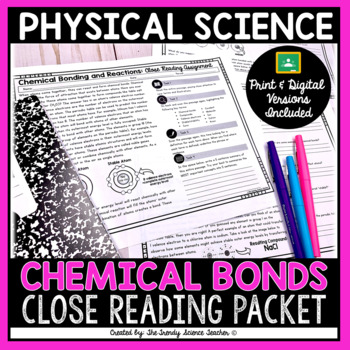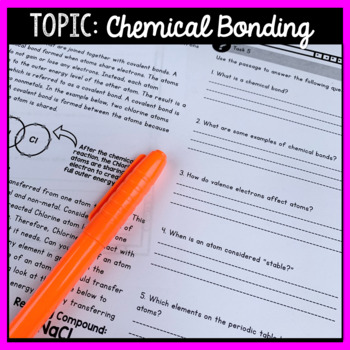Chemical Bonding and Reactions Close Reading Assignment (Print & Digital)
- PDF
- Google Apps™

What educators are saying
Description
Integrate LITERACY and SCIENCE with this Chemical Bonding and Reactions CLOSE reading passage! This resource is great to use as an introduction to Chemical Bonding and Reactions or to use as review and reinforcement over already taught content. The entire 3-page packet is a NO-PREP, PRINT AND GO set, making it perfect for a substitute assignment.
Need a digital option? No problem! I have included a print and digital version of this resource, making it perfect for distance learning, flipped classrooms, online courses and traditional classrooms.
Included in this packet:
⭐3 Page Chemical Bonding Close Reading set (Lexile Level: 900 - 1000)
⭐Answer Key
⭐Digital, Google Slides, version
If you have never used close reading or even if you are already a pro, this print and go packet truly is for you! It has everything you need for a complete, successful informational text reading/science lesson.
This packet is both rigorous and Common-Core aligned and can be used in a variety of grade levels. I use it in my high school inclusion classes, but it can be used for a middle school Physical Science course as well. Please see the Lexile levels to determine if these passages will fit with your students' needs.
►►This assignment pairs GREAT with my Changes in Matter: Physical and Chemical Changes Lab Station Activity!
Other Products that you May Be Interested In:
★ Chemical Bonding and Reactions Unit
★ Forms of Energy Stations Lab (FULLY EDITABLE)
★ Electricity STEM Challenge (Build a GAME using CIRCUITS)
★ Matter Review Maze Worksheet
★ Atomic Structure Scavenger Hunt Activity
Connect with me: ❤️Newsletter ❤️Blog ❤️Facebook ❤️Instagram ❤️Pinterest
►►►Join our Physical Science Teacher Tribe on Facebook for ideas, resources, inspiration and More! Click HERE to join!
TPT Customer Tips:
How to get TPT credit to use on future purchases:
*Please go to your My Purchases page (you may need to login). Beside each purchase you'll see a Provide Feedback button. Simply click it and you will be taken to a page where you can give a quick rating and leave a short comment for the product. Each time you give feedback, TPT gives you feedback credits that you use to lower the cost of your future purchases. Feedback and ratings are most greatly appreciated.
Be the first to know about my sales, discounts, freebies and new products:
*Look for the green star next to my store logo (THE TRENDY SCIENCE TEACHER) and click it to become a follower. That's it! You will now receive email updates about this store.





